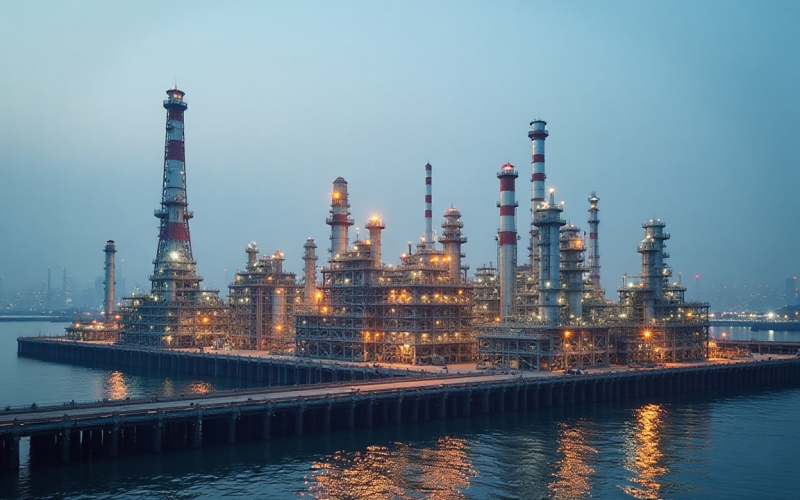In May, China saw a continued increase in crude stock builds, despite a decline in seaborne imports.
Stockpiling rate exceeded 1 million barrels per day in May for the second-consecutive month, Vortexa said in its latest analysis.
In May, China’s seaborne crude imports dropped to below 10 million barrels per day, an 8% decrease from April and a 3% decline year-on-year.
This reduction in volume affected nearly all major suppliers, including Saudi Arabia, Iraq, Russia, and Iran, the shiptracking agency said.
Decline in refining rate
Vortexa’s calculations indicated a 3% year-on-year drop in China’s implied refinery runs, bringing them in line with the three-year seasonal average.
This decline suggests lower average utilisation rates, particularly when considering the significant capacity increases observed in recent years.
The main run rate decline is from independent teapot refiners, who are facing delayed spring maintenance this year.
While their refining margins briefly improved in April, they weakened again in May—contributing to reduced processing activity.
Independent teapot refiners are experiencing a decline in their main run rate, primarily due to delayed spring maintenance, according to Emma Li, senior market analyst at Vortexa.
Despite a brief improvement in April, China’s refining margins weakened again in May, leading to reduced processing activity.
May saw Chinese oil majors experience significant offline capacity due to scheduled maintenance peaking during the month.
Throughput is likely to rebound in June, as several state-run refineries are expected to complete their turnarounds in late May and early June.
“That said, before imports rise meaningfully, China’s stockbuilds could moderate in June, before potentially picking up again in July–August, as cheaper OPEC barrels may arrive after the recent policy adjustments,” Li said.
Lower intake of sanctioned barrels
From April to May, China’s imports of discounted crude from Iran, Russia, and Venezuela decreased from their record highs, indicating a decline in teapot demand.
Even with anticipated widespread maintenance continuing into July, Shandong’s ample onshore inventories enabled teapots to reduce their spot crude purchases, particularly of Iranian oil.
In May, China’s imports of Iranian crude oil fell by almost 30% month-over-month, dropping to less than 1.1 million barrels per day, Vortexa data showed.
This figure is also below the 2024 average of around 1.4 million barrels per day.
“Still, teapots will continue to depend on discounted barrels to preserve margins,” Li added.
With Indian refiners competing for Russian crude—both from western-facing ports and the Far East —Iranian supply remains a key feedstock for China’s independents.
Slowdown in US-sanctioned terminal recover
A temporary operational slowdown at Dongying Port in northern Shandong contributed to the drop in Iranian crude imports in May.
The slowdown occurred after one of the port’s crude terminals was sanctioned by the US Office of Foreign Assets Control (OFAC) in early May.
After approximately a week of disruption, discharge operations at the port gradually recovered.
In May, the port handled over 400,000 barrels per day of crude imports, a decrease compared to the preceding two months, which saw around 520,000 barrels a day, according to Vortexa.
While other Shandong ports may increase STS transfers to non-sanctioned tankers due to OFAC’s latest designation, tightening their compliance protocols, Dongying is expected to remain a primary entry point for Iranian and Russian crude.
Now under sanctions, Dongying is likely to continue accommodating sanctioned tankers.
Offshore North Shandong, at least 12 Aframax tankers, laden with Iranian or Russian crude, were seen at anchor as of June 9, Vortexa data showed.
These vessels are likely awaiting discharge at Dongying.
Diverging demand
Chinese crude oil demand is expected to recover in June.
The anticipated increase is due to the completion of maintenance activities and a rise in transport fuel consumption, driven by the upcoming summer holidays, planting, and fishing seasons, Li added.
“However, continued weakness in other consumer sectors, such as construction and manufacturing, is expected to keep overall refinery runs flat-to-below year-ago levels.”
Chinese onshore crude inventories hit a four-year high of over 1.07 billion barrels by June 8, reducing immediate stockpiling urgency, Vortexa data showed.
However, significant spare capacity allows oil majors to resume builds when market conditions are favorable, Li noted.
Unlike their international counterparts, teapot refiners operate without financial hedging tools and must procure the most affordable feedstock on the spot market.
Li added:
Although persistently weak domestic margins may dampen overall buying appetite, they also incentivise risk-taking, even in the face of ongoing supply-side uncertainty.
The post China’s oil stockpile grows despite falling imports; further stockpiling may depend on market conditions appeared first on Invezz


